Archive:Employment - quarterly statistics
Data extracted in July 2020
Planned article update: October 2020
Highlights
Between the last quarter of 2019 and the first quarter of 2020, the employment rate has remained stable at 73.3% at European level.
Employment rates of young people decreased by 0.3 p.p. (from 33.6% to 33.3%) between the last quarter of 2019 and the first quarter of 2020.
In the first quarter of 2020, employment rates for young men and young women decreased to 35.6% and 30.7% respectively.
Between the last quarter of 2019 and the first quarter of 2020, employment rates decreased by 1.9 p.p. in Luxembourg and by 0.5 p.p. in Estonia, Portugal and Bulgaria, but increased by 0.5 p.p. in Romania and by 1.6 p.p. in Malta.
Temporary contracts continued to decrease since the first quarter 2018, reaching 11.5% of the total employment in the first quarter of 2020.
The recent health crisis due to the COVID-19 pandemic impacted undoubtedly employment in the European Union. In order to keep the expected negative consequences of the COVID-19 crisis on employment and businesses at bay, measures (such as short-time work and financial support to enterprises) were implemented in some EU Member States in the course of March or April 2020. This may, to a certain degree, have kept employed people at work in the initial phase.
However, even if mass dismissals could have been contained in the first instance, hiring may have been directly affected by the pessimistic expectations: enterprises ready to effectively recruit could have withdrawn their vacancies, reconsidered their plans, or put off the recruitment process. People with fixed-term contracts, in probationary periods or trainees may have had, in other times, the opportunity to get a long-term job but instead experienced a job loss due to the COVID-19 downturn. These situations, among others, could have happened very shortly after the beginning of the COVID-19 pandemic. In a second step, enterprises may encounter long-term difficulties due to a change in the economic activities, and lay offs on a larger scale. The crisis also emphasises an economic slowdown which had already started in the last quarters of 2019.
This article focuses on the changes in employment observed during the economic crisis based on the quarterly data from the Labour Force Survey. It shows the recent and long term developments as regards employment, mostly on a global European level but also specifically according to gender, age and level of education attainment. A specific analysis dedicated to the evolution of temporary contracts and part-time work, including underemployed part-time workers, is also presented in this article.
Another article complements this article with a detailed analysis on the evolution of the employed population by occupation, activity sector, age, level of education and professional status, by EU Member State. Both articles are part of the publication Labour market in the light of the COVID-19 pandemic. The current version of these articles focuses on the first quarter of 2020. In October, they will be reviewed in order to include data on the second quarter of 2020.
Note: This article uses seasonal adjusted data from the first quarter of 2020, i.e. January-March 2020, which is compared in some sections with the last quarter of 2019. It is expected that the consequences of the COVID-19 crisis on the labour market will be more visible in the second quarter of 2020 (April-June 2020) given the COVID-19 measures taken in many countries.
Full article
Halt in employment growth in the EU-27
The employment rate stopped growing at the beginning of 2020 for the second time since 2013
Since 2013, the share of employed people in the total EU population kept on growing from one quarter to the next until the third quarter of 2019, where it remained stable compared with the previous quarter for the first time in six years. From the third to the fourth quarter of 2019, the employment rate increased again from 73.1 % to 73.3 %. However, from the last quarter of 2019 (2019Q4) to the first quarter of 2020 (2020Q1), the share of people in employment remained at the same level (i.e. 73.3 %), recording the second flat growth since 2013 (see Figure 1).
The employment of men and women also showed steady shares in their respective total population between 2019Q4 and 2020Q1: 79.1 % of the male population was employed in both quarters, while it was 67.5 % for women.
As regards the labour force (also shortened to active population), which includes both employed and unemployed people, it has remained unchanged over the last four quarters, accounting for 78.2 % of the total population.
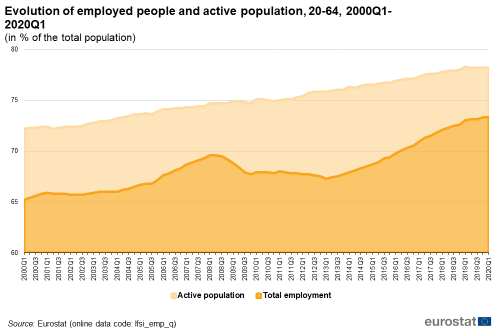
(in % of the total population)
Source: Eurostat (lfsi_emp_q)
In the first quarter of 2020, 73.3 % of people aged 20-64 were employed in the EU. This is a record high since the first quarter of 2000, the starting point of the time series. In terms of comparison, in 2000Q1, less than two thirds of the total population between 20-64 was in employment (65.2 %). The increase over these last 20 years is mainly explained by the substantial and steady growth of employment of senior people, increasing from 34.7 % in 2000Q1 to 59.7 % in 2020Q1, as can be observed in Figure 2.

(in % of the total population)
Source: Eurostat (lfsi_emp_q)
Subdued change in the employment rates in the vast majority of EU Member states
Among the EU Member States, more than 80 % of the population aged 20-64 was employed in Sweden (81.7 %), Estonia (80.7 %), the Netherlands (80.6 %), Germany (80.4 %) and Czechia (80.3 %) in the first quarter of 2020. The lowest employment rates were reported in Greece, Italy, Croatia and Spain, where fewer than seven persons out of 10 were employed at the same period (61.7 % in Greece, 63.6 % in Italy, 67.1 % in Croatia and 67.9 % in Spain).
As at the European level, the share of employed people in the total population in 2020Q1 remained, to a certain extent, the same in most of the Member States compared with the previous quarter. However, the employment rates in Malta and Luxembourg fluctuated by more than 0.5 p.p. between both quarters (an increase of +1.6 p.p. in Malta and a decrease of 1.9 p.p. in Luxembourg). To a lesser extent, Estonia, Portugal and Bulgaria lost 0.5 p.p. in the share of employed people in the total population, reaching respectively 80.7 %, 75.8 % and 74.5 % in 2020Q1, while Romania registered an increase of 0.5 p.p. of the employment rate, resulting in an employment rate of 72.1 % in 2020Q1.

(in % of the total population)
Source: Eurostat (lfsi_emp_q)

(in percentage points)
Source: Eurostat (lfsi_emp_q)
Looking at the specific employment rates of men and women by country in Figure 4, in almost all countries, there was no clear pattern in the evolution of the employment rates. In 23 out of 27 Member States, the evolution of the employment rates for men and women are quite close; very often the difference of variation is at most 0.5 p.p. and not systematically in favour of men or women. In four countries, namely Sweden, Estonia, Malta and Croatia, the difference between men and women in terms of employment rate evolution is, nevertheless, more pronounced. In Sweden and Croatia, the male employment rate stayed at 84.3 % and 72.1 % respectively, while the female employment rate decreased from 79.7 % to 78.9 % (-0.8 p.p.) in Sweden and from 62.7 % to 62.1 % (-0.6 p.p.) in Croatia. In Malta, the female employment rate increased by 3.1 p.p. (reaching 69.4 % in 2020Q1), while the male employment rate increased only by 0.1 p.p. (87.2 % in 2020Q1). Finally, in Estonia, the male employment rate decreased by 1.1 p.p. (83.3 % in 2020Q1) and the female employment rate increased by 0.1 p.p. (78.0 % in 2020Q1).
Young people less employed
Since the first quarter of 2015 until the third quarter of 2019, employment of young people (aged 15-24) increased continuously from one quarter to the next. It then remained stable at around 33.6 % between 2019Q3 and 2019Q4 and decreased to 33.3 % in the first quarter of 2020. The decrease between 2019Q4 and 2020Q1 is similar for young men and young women. While the employment rate changed for young men by -0.3 p.p. between 2019Q4 and 2020Q1, reaching 35.6 % in 2020Q1, it changed by -0.4 p.p. for young women, reaching 30.7 % in 2020Q1 (see Figure 5).
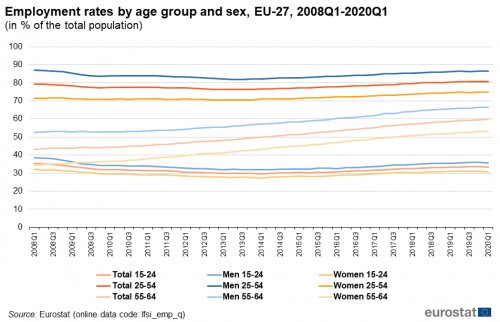
(in % of the total population)
Source: Eurostat (lfsi_emp_q)
Among people in the middle age group, i.e. people aged between 25 and 54, 80.7 % were employed in 2020Q1 against 80.8 % in 2019Q4. For the first time since 2012Q4, the employment rate recorded a decrease, although slight, from one quarter to the next. For men the rate stayed at 86.5 % during the two quarters, while for women it dropped 0.1 p.p. between 2019Q4 and 2020Q1 to reach 74.9 % in the first quarter of 2020.
Over the 10 years between 2009Q2 and 2019Q2, the sustained growth of the share of employed people aged 55-64 from one quarter to the next was clearly visible at EU level. This increase in the share of workers aged 55-64 is partially explained by the job retention for this sub-population, effective retirement age having risen in many countries in the two last decades. However, in 2019, the employment rate for people aged 55-64 did not grow between the second and the third quarter, despite it having been common to record growth from 0.3 to 0.5 p.p. from one quarter to the next in many previous years. From 2019Q4 to 2020Q1 the share of employed people aged 55-64 increased by 0.1 p.p., reaching 59.7 % in 2020Q1. Men registered an increase of 0.2 p.p., resulting in exactly two thirds of the male population aged 55-64 being employed in 2020Q1 (66.6 %), while women recorded an increased of 0.1 p.p., leading to one in two women aged 55-64 in employment in the same quarter (53.2 %). This age category seems to be less affected by the halt in recruiting during the lock-down than young people in the very short-term, but may be more fragile against mass dismissals in the medium term.
Disparate employment rates for men and women with low, medium and high education attainment level
The employment evolution by sex and education attainment level over the period 2005Q1-2020Q1 shows noticeable differences, both for men and women, according to their level of education attainment (see Figure 6). Firstly, the employment rate of men with a high educational level (i.e. tertiary education) is always higher than the employment rate of men with a medium (i.e. upper secondary and post-secondary non-tertiary education) or low educational level (i.e. less than primary, primary and lower secondary education). This was also the case for women. In the same way, people with a medium educational level are proportionately more employed than people with a low educational level. Finally, the lower the education attainment level, the wider the gap between the employment rates of men and women.
As regards people with a high educational level, men and women follow the same developments over time, but maintain a permanent gap between their respective employment rate. Nevertheless, the gender employment gap for those with a high educational level slightly narrowed over time: from 7.9 p.p. in 2005Q1 to 6.3 p.p. in 2020Q1. In 2020Q1, 88.1 % of men and 81.8% of women with a high educational level were employed.
Focusing on men and women with a medium level of education attainment, their employment rate followed the same trend over the period 2005Q1-2020Q1, although the fluctuations can be slightly more or less pronounced for men or women. The employment rate of women with a medium educational level was never equal to that of men. A gender employment gap was present over the whole period 2005Q1-2020Q1. It corresponded to 13.3 p.p. in 2005Q1, decreased to 11.4 p.p. in 2014Q1 and reached 12.4 p.p. in 2020Q1. In the first quarter of 2020, almost eight out of ten men with a medium educational level (79.4 %) were employed against less than seven out of ten women (67.0 %).
Finally, the employment rate of men with a low educational level corresponded to 66.6 % in 2020Q1; this is exactly two out of three men with a low level of education attainment who were employed in the first quarter of 2020. For women, the employment rate was 44.4 % in that quarter, meaning that less than half of the women with a low education attainment level were employed. The gap between men and women was 26.2 p.p. in 2005Q1, went down to 18.5p.p. in 2013Q3, and increased to 22.2 p.p. in 2020Q1. As with people with a medium educational level, the gap narrowed when the total employment was reducing and the gap widened when the total employment was on the upswing.
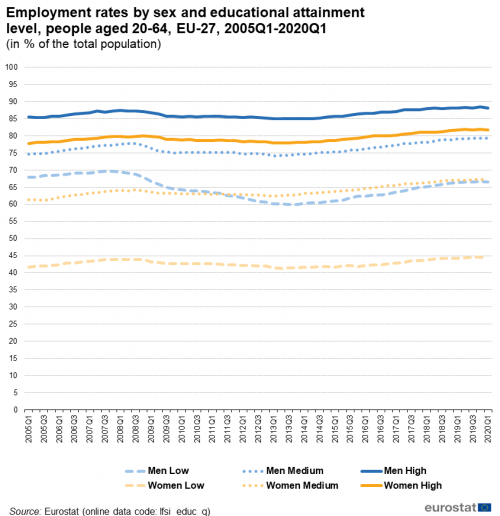
(in % of the total population)
Source: Eurostat (lfsi_educ_q)
Fewer temporary contracts, part-time employment unchanged
Confirmed downward trend in temporary contracts
In 2020Q1, slightly more than one out of 10 employed persons in the EU-27 were employed under temporary contracts (11.5 %). From 2013Q1 to 2017Q2, temporary contracts had a slight positive trend reaching 23.3 million people, accounting for 12.5 % of the total employment in 2017Q2. After three consecutive quarters recording relatively flat evolution, the share of temporary contracts went slightly down from 2018Q2 to 2020Q1 and got back to the level registered at the beginning of 2013, i.e. 11.5 %, corresponding to 22.0 million people (see Figure 7).

(in thousand persons)
Source: Eurostat (lfsi_pt_q)
Among the EU Member States, except Germany for which data is not available, 17 out of 26 EU countries registered a decrease in the share of temporary contracts in the total employment between the last quarter of 2019 and the first quarter of 2020. At European level, it decreased by 0.2 p.p. In Malta, Croatia, Poland, Portugal and Luxembourg, the percentage of temporary contracts in total employment decreased by more than 0.5p;p. between both quarters (-2.1 p.p. in Malta, -1.2 p.p. in Croatia, -0.9 p.p. in Poland and Portugal and -0.7 p.p. in Luxembourg). Spain (21.7 %), Portugal (17.2 %), Poland (16.2 %) and Croatia (15.5 %) registered the highest shares of temporary contracts in 2020Q1, each exceeding 15% of the total employment.
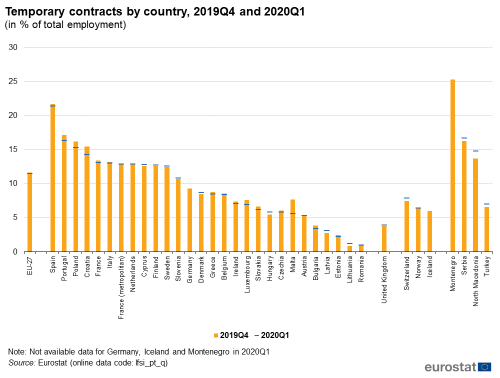
(in % of total employment)
Source: Eurostat (lfsi_pt_q)
Part-time employment at the same level in the last four quarters
In the EU-27, 33.9 million people reported part-time employment in the first quarter of 2020, corresponding to 17.8 % of the total employment, exactly the same percentage as registered in the second, third and fourth quarters of 2019 (see Figure 7). From 2008 to 2015, the overall upward trend of part-time employment is relatively smooth and continued: it accounted for 29.5 million people, corresponding to 15.9 % of the total employment in the first quarter of 2008, and reached 33.2 million, corresponding to 18.3 % of the total employment in the first quarter of 2015. From 2015 onward, the share of part-time workers slightly decreased.
Some EU Member States recorded an increase in the share of part-time workers greater than 0.5 p.p. between 2019Q4 and 2020Q1: Latvia (+2.3 p.p.), Luxembourg (+1.6 p.p.), Estonia (+1.0 p.p.), Croatia and Hungary (both +0.5 p.p.) (see Figure 9).
Another relevant aspect related to part-time employment is the underemployed part-time workers; these are persons working part-time, wishing to work additional hours and are available to do so. At EU level, underemployed part-time workers accounted for 3.1 % of the total employment, both for 2019Q4 and 2020Q1; no change has been observed between the two quarters. Nevertheless, at country level, the share of underemployed part-time workers decreased by 0.5 p.p. in Spain and Malta, reaching 5.7 % and 1.3 % of the total employment respectively. By contrast, increases of 0.5 p.p. or more in the shares of underemployed part-time workers were observed in Italy (+0.5 p.p.), Slovenia (+0.5 p.p.) and Latvia (+1 p.p.), reaching 3.4 %, 1.6 % and 3.6 % respectively.
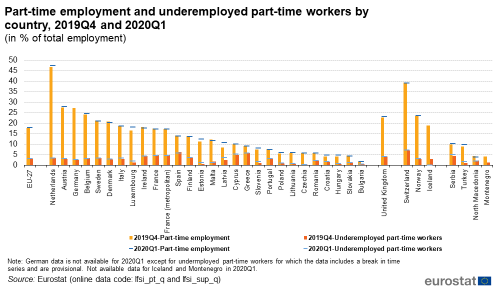
(in % of total employment)
Source: Eurostat (lfsi_pt_q) and (lfsi_sup_q)
Source data for tables and graphs
Data sources
All figures in this article are based on seasonally adjusted quarterly results from European labour force survey (EU-LFS).
Source: The European Union labour force survey (EU-LFS) is the largest European household sample survey providing quarterly and annual results on labour participation of people aged 15 and over as well as on persons outside the labour force. It covers residents in private households. Conscripts in military or community service are not included in the results. The EU-LFS is based on the same target populations and uses the same definitions in all countries, which means that the results are comparable between countries.
European aggregates: EU refers to the sum of EU-27 Member States. If data are unavailable for a country, the calculation of the corresponding aggregates takes into account the data for the same country for the most recent period available. Such cases are indicated.
Definitions: The concepts and definitions used in the labour force survey follow the guidelines of the International Labour Organisation.
Five different articles on detailed technical and methodological information are linked from the overview page of the online publication EU labour force survey.
Context
The COVID-19 virus hit Europe in January and February 2020, with the first cases confirmed in Spain, France and Italy. COVID-19 infections have now been diagnosed in all European Union (EU) Member States.
To fight the pandemic, EU Member States have taken a wide variety of measures.
From the second week of March, most countries closed retail shops apart from supermarkets, pharmacies and banks. Bars, restaurants and hotels have also been closed. In Italy and Spain, non-essential production was stopped and several countries imposed regional or even national lock-down measures which further stifled the economic activities in many areas.
In addition, schools were closed, public events were cancelled and private gatherings (with numbers of persons varying from 2 to 50) were banned in most Member States.
The large majority of the prevention measures were taken during mid-March 2020 and most of the prevention measures and restrictions were kept for the whole of April and May 2020.
The first quarter of 2020 is consequently the first quarter in which the labour market across the EU has been affected by COVID-19 measures taken by the Member States.
Employment and unemployment as defined by the ILO concept are, in this particular situation, not sufficient to describe the developments taking place in the labour market. In this first phase of the crisis, active measures to contain employment losses led to absences from work rather than dismissals, and individuals could not search for work or were not available due to the containment measures, thus not counting as unemployed.
The quarterly data on employment will allow along the quarters to report on the impact of the economic crisis on employment. This specific article focuses on the age and the level of education attainment of employed people in order to determine potential categories more or less affected by the economic downturn. It will also emphasize the evolution of part-time employment and temporary contracts. A supplementing article to this current article on the evolution of employment by activity and professional status is also available in the context of the publication
Direct access to
- All articles on employment
- Labour market in the light of the COVID 19 pandemic - quarterly statistics
- Employment rates and Europe 2020 national targets
- Job vacancy statistics
- Labour market statistics at regional level
- People outside the labour force
- The EU in the world - labour market
- Labour market slack – annual statistics on unmet needs for employment
- LFS main indicators (t_lfsi)
- Population, activity and inactivity - LFS adjusted series (t_lfsi_act)
- Employment - LFS adjusted series (t_lfsi_emp)
- Unemployment - LFS adjusted series (t_une)
- LFS series - Detailed annual survey results (t_lfsa)
- LFS series - Specific topics (t_lfst)
- LFS main indicators (lfsi)
- Employment and activity - LFS adjusted series (lfsi_emp)
- Unemployment - LFS adjusted series (une)
- Labour market transitions - LFS longitudinal data (lfsi_long)
- LFS series - Detailed quarterly survey results (from 1998 onwards) (lfsq)
- LFS series - Detailed annual survey results (lfsa)
- LFS series - Specific topics (lfst)
- LFS ad-hoc modules (lfso)
Publications
- EU labour force survey — online publication
- Labour Force Survey in the EU, candidate and EFTA countries — Main characteristics of national surveys, 2017, 2018 edition
- Quality Report of the European Union Labour Force Survey 2017, 2019 edition
ESMS metadata files and EU-LFS methodology
- Employment and unemployment (Labour Force Survey) (ESMS metadata file — employ_esms)
- Employment growth and activity branches - annual averages (ESMS metadata file — lfsi_grt_a_esms)
- LFS ad-hoc modules (ESMS metadata file — lfso_esms)
- LFS main indicators (ESMS metadata file — lfsi_esms)
- LFS series - Detailed annual survey results (ESMS metadata file — lfsa_esms)
- LFS series - detailed quarterly survey results (from 1998 onwards) (ESMS metadata file — lfsq_esms)